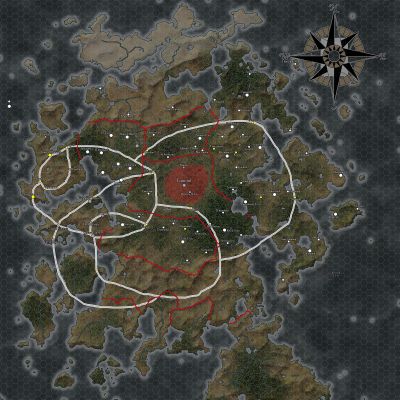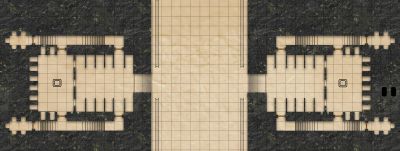Liminal Stoneways
An ancient construction of the old dwarven kings, the Stoneways are a massive system of tightly-sealed tunnels - constructed by interlocking stone blocks of the strongest granite. It extends outward from the old dwarven citadels of old, and reaches as far east as the Empire of the Nine, with a spur that extends even into the lands south of the Ilandor Mountains. Access to the Stoneways is a Guild secret. Access points into the Stoneways are only through Guild posts, whether important Guilds structures in towns, or through back-country outposts built mainly to house such a Stonegate.
The Stonegates
The Stonegates are incredibly complex portals, wide enough and tall enough to allow the passage of two wagons abreast at the same time. When sealed, they are nigh-unopenable, save by Guildsfolk of at least Journeyfolk status, for they use intricate clockwork locking mechanisms that do not use keys but complex moving puzzle-parts which users must "solve" in order to open. A failed attempt to open one causes the puzzle-lock to shut down into a locked state, requiring a special key - only ever entrusted to a Master given guardianship over that gate - to reset. These Masters, referred to as Clavigers in the Guilds structure, are sworn to protect and defend the key in question, and each is unique, resetting the puzzle-lock of only one Stonegate. The Guilds are said to possess magics that allow them to track stolen keys magically.
Travel
Traveling the passages of the Stoneways is almost luxurious, save that they are pitch-black. The surface is smooth and well-constructed, easing travel for wagon and mount alike. Travel is blissfully protected from predation by monster or exposure to bad weather, and the tunnel passages are level. This counts as traveling via road for the purpose of travel times, and the DC increase for Forced Marches only start increasing after the first two hours of a forced march, thanks to the ease of travel.
Physical Construction
The tunnels themselves are wrought of interlocking, masterfully-crafted stones of uniform size and shapes. There are six different sizes and shapes of stone, which fit together like puzzle pieces in repeating patterns. The stone used to create the Stoneways have been taken from all over Rinhony, based on whatever is the hardest stone available in a given area. These stones make up the floors, walls, and ceiling of the tunnels, and seem to fit together cunningly without mortar - a true feat of dwarven engineering and craftsmanship.
The pathways also boast two sluice-channels three feet in width down either side of the corridor, which slopes gently toward those channels (which have raised edges to prevent wagons or animals from accidentally ending up in them), where animal waste is easily sluiced down into the channels by water, terminating in great fertilizer pits accessible every hundred feet by puzzle locks whose operation is known only to the Stoneways Keepers, who gather the fertilizer for sale along their routes. This entire system is flushed full of running water twice a year by channels that take advantage of spring melt in the mountains, and by autumn storms.
Waterways
A complex system of aqueducts flows adjacent to the Stoneways, and every ten miles there is a watering-point. A watering-point is a bit of construction built in the wall of the Stoneway, consisting of a large, wide watering trough and two pumps that tap into the aqueducts some ten feet behind the wall. Travelers along the Stoneway can stop to refill their own waterskins and barrels there, as well as water animals. The machinery is not complicated, but there are literally hundreds of such stations along the length of the Stoneways, so approximately one in four of these stations are not functioning, waiting for a crew of Keepers to perform repairs.
Camp-Junctions
Camp junctions are points in the tunnels that have two large and wide chambers have been built into the walls of the tunnel. Each one has two "levels" - a lower stables level where horses and wagons can be safely stowed, with a staircase that leads up to a camp level that overlooks the stables. There are camp-junctions every 40 miles or so (a distance that presupposes guild caravans traveling at Fast speed for ten hours a day).
- Entryways: Each entryway is through a twenty-foot wide archway, flanked by two unlit torches. When a group of travelers take possession of a junction, it is tradition to light the torches to show they are occupied, lighting a single torch if they are extending a welcome to other travelers to join them, or both if they wish to be left in peace. Through this archway, a gentle ramp slopes upward and into the stables area.
- Stables Area: Wagons are usually backed into the space here, which can hold around three normal-sized caravan wagons if they're tightly packed, with stable space for animals. These spaces do not have fodder (caravans here carry their own), but they do have access to a watering-point. Three large windows about ten or so feet above the stables floor look down on the space from the camp area above, and a pair of doors leads to the stair-tunnels.
- Stair-Tunnels: Running alongside both edges of the camp junction are a pair of tunnels which open from the stables, climb a set of stairs to a door that leads to the camp areas, and also continues downward again, this time ending in a set of five jakes behind another door, with individual jakes behind curtained alcoves.
- Camp Area: The camp area is a wide-open space perfect for resting. Twenty alcoves are built into the wall here, with one alcove a few feet off the ground and then another ten feet above it, accessible through ladder-rungs carved into the wall next to the alcove openings. A large fire pit sits in the center of the space, ringed with stone seats. In one wall is a watering-point, and in the wall opposite it is a charcoal pit that is refilled by Keeper crews doing maintenance (although it's not uncommon to find the supply well depleted or even empty).
Stoneways Keepers
Small crews of eight craftsmen travel the Stoneways at all times. There are perhaps a dozen of such crews in all, and they are made up of:
- Ironwright: A journeyfolk of the Ancient and Revered Order of Ironwrights, along with a portable anvil and forge. This Keeper oversees the ironmongery used in the camp-junctions and watering-points.
- Stonewrights: Four journeyfolk and one master of the Sacred Stonewright's Guild form the heart of the Keeper's patrol, ready to work repairs where and when it is needed. Though each Keeper's wagon carries some amount of stone, they also keep note of larger damage that will need bigger and more dedicated repairs than a Keeper patrol can provide. The master - who is familiar with the secrets of the Stoneways engineering and design - is in charge of the patrol, issuing orders to the others.
- Spellwright: An apprentice spellwright also accompanies the Keeper patrol, armed with a decanter of endless water and an assortment of other small spells and rituals used to provide aid where they can. Though their presence is necessary, most spellwrights consider assignment to a Keeper patrol to be a form of punishment.
- Teamsters: Two journeyfolk of the Steady & Sinewed Guild of Teamsters come along the patrol to handle the oxen and wagon.
These crews maintain large, wide-draft wagons onto which are loaded the team's needs for the trip: raw slabs of stone waiting to be fashioned into one of the six shapes used in the tunnels, a portable forge and anvil and supply of iron ingots, wood and rope for repairs to the wagon, feed for the mounts and oxen, and the team's possessions. These wagons are pulled by a pair of massive oxen, and can generally carry a full load plus four travelers at once. Lanterns hung with a slight green tint are hung along the sides of the wagons, allowing travelers to identify Keeper crews even from a distance.

